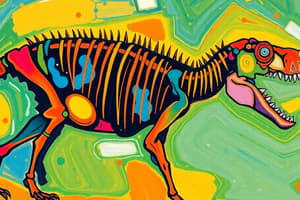Podcast
Questions and Answers
What is the consistent finding about Porifera (sponges)?
What is the consistent finding about Porifera (sponges)?
- They are closely related to cnidarians
- They constitute a monophyletic group (correct)
- They are the ancestors of Bilateria
- They are not a monophyletic group
Which group of animals branched off the tree before the origin of animals with bilateral symmetry?
Which group of animals branched off the tree before the origin of animals with bilateral symmetry?
- Cnidarians (correct)
- Deuterostomes
- Protostomes
- Bilateria
What has been a significant change in phylogeny due to molecular data?
What has been a significant change in phylogeny due to molecular data?
- The origin of Bilateria
- The phylogeny of protostomes (correct)
- The phylogeny of deuterostomes
- The relationship between cnidarians and Bilateria
What is the current debate regarding Ctenophores?
What is the current debate regarding Ctenophores?
Why is the state of the coelom not a reliable character to infer phylogenetic relationships?
Why is the state of the coelom not a reliable character to infer phylogenetic relationships?
What is a characteristic of Lophotrochozoans?
What is a characteristic of Lophotrochozoans?
What is a characteristic of Ecdysozoans?
What is a characteristic of Ecdysozoans?
What is a characteristic of all deuterostomes?
What is a characteristic of all deuterostomes?
What is the main difference between Deuterostomes and Protostomes?
What is the main difference between Deuterostomes and Protostomes?
What is the characteristic of Echinoderms?
What is the characteristic of Echinoderms?
What is the name of the Kingdom that includes animals with true tissues?
What is the name of the Kingdom that includes animals with true tissues?
What is the name of the Phylum that includes Sponges?
What is the name of the Phylum that includes Sponges?
What is the characteristic of Sponges' growth forms?
What is the characteristic of Sponges' growth forms?
What is the characteristic of Sponges' movement?
What is the characteristic of Sponges' movement?
What is the characteristic of Sponges' cells?
What is the characteristic of Sponges' cells?
What is the structure of Sponges?
What is the structure of Sponges?
Flashcards are hidden until you start studying
Study Notes
Phylogeny of Animals
- Porifera (sponges) form a monophyletic group, meaning they consist of all descendants from one common ancestor.
- Cnidarians (hydras, sea jellies, and corals) branch off the tree before the origin of animals with bilateral symmetry (Bilateria).
Annelids and Arthropods
- Annelids (worms) and arthropods (spiders) are in separate clades (Lophotrochozoa and Ecdysozoa) despite both exhibiting segmentation.
Ctenophores and Chaetognatha
- The position of Ctenophores (sea walnuts) is currently debated.
- Whether Chaetognatha (marine worms) is a protostome or a deuterostome is unclear.
Phylogeny of Deuterostomes and Protostomes
- Deuterostomes have coeloms; protostomes are variable.
- Protostomes are divided into two clades: Lophotrochozoans (grow by gradual addition of mass) and Ecdysozoans (animals that molt, including arthropods).
Deuterostome Divisions
- Deuterostomes consist of fewer phyla and species than protostomes.
- They are more uniform in many ways, despite great differences in appearance.
- Deuterostomes include echinoderms (invertebrate marine animals) and chordates (mammals, fish, reptiles, and amphibians).
Kingdom Animalia (Metazoa)
- Kingdom Animalia is divided into two branches: Parazoa and Eumetazoa.
- Parazoa includes animals lacking tissues and organs, such as sponges.
- Eumetazoa includes animals with true tissues, organs, and organ systems.
Phylum Porifera (Sponges)
- Sponges are marine animals, with 26,000 species, and 150 freshwater species.
- Most sponges lack symmetry, have various growth forms, and some are capable of movement.
Sponge Characteristics
- Sponges have a "vaselike" shape with three functional layers of cells.
- They consist of a gelatinous noncellular layer (mesohyl) between two cell layers.
- Sponges are multicellular but lack organized tissue.
Studying That Suits You
Use AI to generate personalized quizzes and flashcards to suit your learning preferences.




